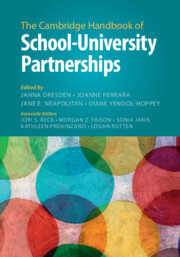Book contents
- The Cambridge Handbook of School–University Partnerships
- The Cambridge Handbook of School–University Partnerships
- Copyright page
- Contents
- Figures
- Tables
- Contributors
- Foreword
- Preface
- Acknowledgments
- Part I The History and Conceptual Foundations of School–University Partnerships
- Part II Teachers and Learning to Teach in School–University Partnerships
- Part III Equity and Student Learning in School–University Partnerships
- Part IV Leadership in School–University Partnerships
- Part V Community Schools as School–University Partnerships
- Introduction to Part V: Community Schools as School–University Partnerships
- 32 Realizing Higher Education’s Democratic Promise through University-Assisted Community Schools
- 33 University-Assisted Community Schools
- 34 School–University Partnerships Supporting the Transformative Potential of Community Schools
- 35 Creating Win-Win Relationships between Community Schools and Higher Education
- 36 Commentary: University-Assisted Community Schools
- Part VI Inquiry and Innovation in School–University Partnerships
- Part VII Funding, Policy, and the Politics of School–University Partnerships
- Part VIII Looking at School–University Partnerships across Geographic and Cultural Borders
- Index
- References
34 - School–University Partnerships Supporting the Transformative Potential of Community Schools
from Part V - Community Schools as School–University Partnerships
Published online by Cambridge University Press: 05 November 2025
- The Cambridge Handbook of School–University Partnerships
- The Cambridge Handbook of School–University Partnerships
- Copyright page
- Contents
- Figures
- Tables
- Contributors
- Foreword
- Preface
- Acknowledgments
- Part I The History and Conceptual Foundations of School–University Partnerships
- Part II Teachers and Learning to Teach in School–University Partnerships
- Part III Equity and Student Learning in School–University Partnerships
- Part IV Leadership in School–University Partnerships
- Part V Community Schools as School–University Partnerships
- Introduction to Part V: Community Schools as School–University Partnerships
- 32 Realizing Higher Education’s Democratic Promise through University-Assisted Community Schools
- 33 University-Assisted Community Schools
- 34 School–University Partnerships Supporting the Transformative Potential of Community Schools
- 35 Creating Win-Win Relationships between Community Schools and Higher Education
- 36 Commentary: University-Assisted Community Schools
- Part VI Inquiry and Innovation in School–University Partnerships
- Part VII Funding, Policy, and the Politics of School–University Partnerships
- Part VIII Looking at School–University Partnerships across Geographic and Cultural Borders
- Index
- References
Summary
Community schools, an equity-oriented reform strategy, has expanded significantly in recent years. To achieve their goals, community schools engage partners that operate outside the traditional K-12 realm. School–University partnerships are one key example of collaboration that have a transformative potential to impact the effectiveness of community schools. While these partnerships hold great potential to advance the vision and mission of community schools, there are also many barriers to the development, sustainability, and growth of meaningful partnerships between universities and community schools. This chapter provides an overview of the community school strategy, outlines both opportunities and challenges in partnerships between universities and community schools, and highlights examples from the field to illustrate some key learnings to establishing sustained partnerships. This chapter aims to contribute to a more open and honest discussions around community school and university partnerships for education equity.
Keywords
Information
- Type
- Chapter
- Information
- The Cambridge Handbook of School–University Partnerships , pp. 501 - 517Publisher: Cambridge University PressPrint publication year: 2025
References
Accessibility standard: WCAG 2.1 AA
Why this information is here
This section outlines the accessibility features of this content - including support for screen readers, full keyboard navigation and high-contrast display options. This may not be relevant for you.Accessibility Information
Content Navigation
Allows you to navigate directly to chapters, sections, or non‐text items through a linked table of contents, reducing the need for extensive scrolling.
Provides an interactive index, letting you go straight to where a term or subject appears in the text without manual searching.
Reading Order & Textual Equivalents
You will encounter all content (including footnotes, captions, etc.) in a clear, sequential flow, making it easier to follow with assistive tools like screen readers.
Visual Accessibility
You will still understand key ideas or prompts without relying solely on colour, which is especially helpful if you have colour vision deficiencies.
Structural and Technical Features
You gain clarity from ARIA (Accessible Rich Internet Applications) roles and attributes, as they help assistive technologies interpret how each part of the content functions.
